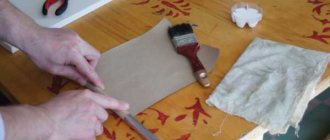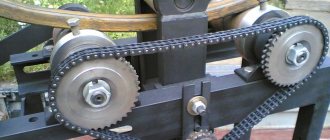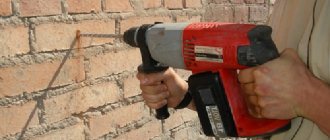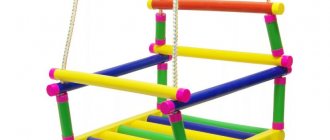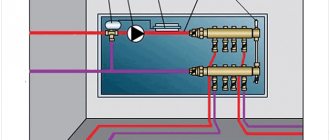How to make a pipe clamp with your own hands
At the first signs of depressurization of the pipeline, it is necessary to quickly find the damaged area and eliminate the identified defect. When performing emergency emergency work, you can use homemade clamps to stop the flow in the pipeline for a while.
Ready-made clamps for fastening pipes, made in the factory from stainless steel or fire-resistant plastic, are used when performing installation work on the installation of heating, sewerage, water supply, and gas supply systems.
These fasteners allow you to reliably fix the position of pipes running along horizontal and vertical surfaces (ceilings, walls), as well as those installed on special racks.
In this video, an experienced craftsman shows how to make a wire clamp:
How to repair a fistula in a pipe
How to repair a fistula in a pipe. Sometimes a situation occurs that a fistula appears in an iron pipe of a water supply or heating riser. This is especially common in hot water risers. The first signs that a pipe will soon burst is when a red growth appears on it, but it may not appear.
In scientific terms it is called pitting corrosion, but in simple terms it is “Pipe” to a pipe. Fistulas appear on the pipe, either due to wear or due to stray currents.
In principle, when you get a fistula, you won’t care why it appeared, you will have a question: how to fix it quickly? I'll try to describe a couple of options on how to do this.
How to seal a fistula in a pipe with a clamp
In general, if you see that your pipe is not of the first freshness, then it is advisable to purchase a couple of clamps in advance for the diameter of the water supply riser, and cut rubber for them. Because most often this happens at night, and by the time the emergency crew or mechanic arrives, it can be heavily flooded. There are a couple more nuances regarding the size of the fistula.
If the fistula is the diameter of a needle, then you can install a clamp without shutting off the water, but if it is larger, then when installing the clamp, you risk getting burned; if the fistula is in a pipe with hot water, it is better to turn off the water at the riser. If the fistula is small, you can try to seal it with a regular car clamp, as in the photo.
You do this: take a piece of rubber and cut out a thin ribbon, the width of the ribbon should be equal to the width of the clamp, maybe 3-4 millimeters more, but not less, now measure the length of the rubber band. We wrap it around the pipe and cut off the excess. Then cut off another 1 cm. Next, open the clamp, put it on the pipe, and grab it a little.
We insert the rubber gasket that you cut out under it and carefully bring it to the place where the fistula has formed. Cover it and tighten it with a screwdriver or a wrench, depending on what kind of tightening device the clamp has.
I have had such cases in practice that in an apartment there is a fistula with the diameter of the “eye of a needle”, it whistles very loudly, but there is not a lot of water, the tenant, the grandmother “God’s dandelion” is screaming like crazy, but I can’t turn off the water, since it is from won’t let me out of the apartment, and I didn’t have the clamp with me, what I do, after looking and determining that the pipe is in excellent condition, I break off a piece of a match, and insert the tip into the fistula, and there was no fistula, but this is so that the grandmother calmed down. Then, of course, I installed the clamp. I often closed such fistulas in the basement this way, but there were also punctures, you insert a match, and the fistula becomes 2 times larger, so I do not advise you to use this method. Well, this is a digression, let's consider another option.
Recommendations
Before purchasing any item, carefully check it for any sharp protruding parts. It is because of them that the pipe ruptures in the future.
Inspect the surface of the clamp: high-quality spare parts always indicate the nominal diameter. Check with your consultant about the type of connection you need for its intended purpose. During the installation process, do not pinch the pipe with a clamp. This will cause cracks and damage to parts.
You can find out more about how to choose a high-quality clamp for clamping a hose.
Source: stroy-podskazka.ru
Types of clamps for water pipes
Crimping clamps for a water pipe are selected depending on the diameter and operating conditions. For large diameter pipes, devices consisting of several parts are used. During installation, each part is connected to the adjacent one using fastening material - steel bolts of various diameters.
For vertically located structures, it is provided not only for crimping the pipes, but also for fastening them to the wall. In this case, one part is first screwed to the wall, a pipe is laid into it and the second part is screwed.
Double-sided bandages consist of two parts, bolted on both sides. Manufactured for pipes of different diameters. Some varieties require a tee connection and have a special outlet.
Single-sided bandages are designed for pipes of small diameter (up to 5 cm), made of flexible metal, fastening is made from the top on one side.
Plumbing clamps with rubber seals are made of aluminized material with precise connection of the edges, therefore they ensure a tight fit of the pipe on all sides. The rubber seal prevents leaks during repair work.
Varieties:
- With wide tape – up to 12 mm. They are used in places where the pressure in the system is higher.
- The plumbing clamp differs from other models in that it has a smooth inner surface.
- Bandage with a key. It is convenient to use if you do not have a screwdriver at hand, but the wrench can create excessive tightening, so it is advantageous to use a worm-wheel clamp.
- Metal tape - you can make it yourself from clamp tape and clamps, so as not to buy separately for each pipe diameter.
- Power bands are used on hoses of pumping systems.
- Wire – reduce the level of vibration in the sewerage system and pump hoses.
- Reinforced. Instead of screws, bolts and nuts are used.
Reliable manufacturers of clamps pay attention to both the thickness of the profile and the quality of fastenings, which account for more than 60% of the load. The wear resistance of gaskets is determined by the quality of the rubber: it must withstand temperature changes, high humidity and exposure to chemicals that may flow through pipes in need of repair.
Band metal clamps
Most often, this type of fastener comes standard at the factory. This is due to reliable fixation and ease of installation. In order for the CV joint clamp to be used for a long time, the following conditions must be met:
- when making the tape, the manufacturer used high-quality steel;
- installation on the boot was carried out using a device for tightening CV joint band clamps;
- To install fasteners, you must have skills in using the tool.
To tighten the CV joint clamps, you can use improvised means, but the quality in this case will depend only on the experience of the craftsman. The only tool you need is pliers. Sequence for tightening the clamp:
- The clamp fits onto the boot;
- The tip is grabbed with pliers;
- Pull with a little force and make sure that the clamp tightens the boot without distortion;
- Create maximum force and bend upward;
- Bend the antennae;
- Fasten the end of the ribbon.
Upon completion of installation on the constant velocity joint, it is necessary to check the uniform fit of the clamp and the absence of distortions.
Varieties
Clamps are presented on the construction market in a wide range. Models are produced in a wide variety of standard sizes and are divided according to such characteristics as the method of fixation, the presence of a seal, shape, material of manufacture and purpose.
Based on the material used, products are divided into plastic and steel. Moreover, steel elements can be made either with or without galvanization. Compared to plastic models, steel clamps are considered more in demand and popular. This is due to the low cost of the products, good tensile strength of the metal and high strength. The disadvantage of metal clamps is the low resistance of non-galvanized models to corrosion processes. Therefore, in cases where the installation of clamps is planned in extremely humid rooms, you should choose models made of stainless steel or clamps coated with zinc.
Plastic options are characterized by increased elasticity, high resistance to vibration and the ability to create movable fixation. Models can be used for fastening pipelines with a diameter of no more than 10 cm.
Depending on the tasks assigned to them, clamps are divided into spiral, power, wire, worm, pipe and mortise options.
A spiral clamp is a fairly common device and is intended for rigid fixation of pipes in the system.
The power one has the shape of a tape with holes for bolts and is indispensable when working on lines with increased operating pressure, at pumping stations, pneumatic and hydraulic systems.
Wire clamps are presented in the form of one or several steel rings equipped with tightening fasteners. The model is designed for corrugated pipes and is indispensable for fixing them during strong movements.
The worm model is a steel strip with a track, equipped with teeth and screws for tightening. The model is used in the construction of heating systems, as well as as a fixing mechanism for pipelines exposed to severe vibrations.
Pipe clamps are presented in the form of rings with brackets and are installed to secure the pipeline in cases where it is necessary to reduce the internal stress in the system during repairs.
The spring clamp has a fairly narrow specialization and is used on pipes subject to linear expansion.
A mortise, or saddle, clamp with a branch is a more complex mechanism and is designed for installation in places where the pipeline branches. Its main difference from traditional models is the presence of a coupling equipped with threaded pipes, which allows you to insert the clamp into the system and quickly connect an additional branch. The tightness of such a connection is ensured by a gasket located inside the clamp and made of profiled rubber.
Pivot models, also known as hinge locks, are used to install scaffolding and are used when attaching diagonal type braces. Thanks to the rotary clamps, all elements can be fixed at any angle, which gives additional strength to the structure and ensures its stability.
According to the type of fixation, all clamps are divided into two types:
- The first include models that form a rigid type of fastening, in which the pipe becomes completely motionless. The crimping brackets of such products are securely tightened with bolts, and the clamp itself is firmly attached to the wall. This type of fastening is used in areas where the pipeline bends and in the presence of branches.
- The second type includes models with movable fastenings, used for fixing heating and hot water pipes. The specificity of the fastening does not create obstacles to the elongation and compression of the pipeline and ensures its longitudinal mobility. As a result, an optimal line voltage is created, significantly extending the life of the networks.
Structurally, clamps are available in several types:
- a split ring, formed in the form of a circle and having one fastening mechanism, fixed with a bolt;
- a ring consisting of two semicircular plates and having fastening ears on both sides;
- a tape folded into a ring and having several positions for fixation;
- A U-shaped model, often made of plastic, equipped with a locking latch and capable of being attached in a rigid and movable manner at the same time.
Features of mortise models
In places where it is intended to create a branching point for the pipeline without using fittings, mortise clamps for the pipe are installed.
The main difference between mortise fasteners is the coupling of a special design, which is equipped with a threaded pipe that allows you to embed a branch line to the main one
Clamps for tapping into the pipe body are installed on a pre-drilled hole.
The built-in threaded pipe allows you to connect an additional section of pipeline in a matter of minutes. A gasket attached to the inside of the clamp body ensures the tightness of the connection.
Advantages of adhesive pipe joints
When installing and repairing water supply and wastewater systems, welding is more often used. Installation of PVC pipes under glue is less common. Although a connection using an adhesive composition is not inferior in quality.
To assemble PVC products in contact with hot water, you need to select the appropriate brands. Most options are only reliable for cold water pipes.
Advantages of adhesives:
- Inexpensive, fast, easy to assemble. No additional equipment or components required.
- Low probability of leaks. When using a special clamp, the parts are connected hermetically. Disconnection is only possible when exposed to hot water.
- Low energy consumption. No electricity is required to fasten parts together using this method.
- Speed of work. The joints harden within a few minutes.
- Can be used for water supply and sewerage.
- Use for diameter range 6–400 mm.
Features of worm clamps and their application
Worm-type clamps are a one-piece stamped fastener equipped with a special fastening lock. Worm products are used for the following needs:
- for connecting water supply networks, pipes, hoses and other lines;
- for fixing heating systems in place;
- for fastening pipes under increased vibration.
Worm-and-worm clamps are very often used for high loads because they are extremely difficult to break or even stretch. In addition, worm-type products are resistant to any mechanical stress. Worm-worm structures will not lose their tightness, even if they are used several times.
Worm-type products are produced by pressing or by cutting or knurling. In their production, great emphasis is placed on processing the tape, ensuring that there are no sharp edges, and that pipes and hoses cannot be damaged.
Typical dimensions of the worm structure are:
- tape length 0.8 – 24 cm;
- width 0.9 – 1.2 cm;
- metal thickness 0.7-0.9 mm.
In addition to size, worm structures differ from each other in the metal they are made of. It is always steel, but it can be different:
- galvanized;
- stainless and easily magnetized;
- stainless and poorly magnetized;
- anti-magnetic stainless steel.
Structural features of worm-drive clamps
Worm-worm clamps are mainly used for sealing pneumatic and hydraulic systems. The dimensions of the structure and fasteners are determined by GOST and differ depending on the type of worm clamp and its series.
For example, according to one of the GOSTs, a worm-wheel clamp is a single structure, where the surface of parts based on carbon steel is coated with zinc and chromated. The worm clamp also includes a belt that has a toothed track, as well as a screw or bolt that can tighten the fastener. This pair (tape and bolt) is a stepless surface, which ensures uniform tightening of the pipe and sealing of its joints.
Screw heads can be of the following types:
- hexagonal;
- including a splined groove;
- including cross-shaped bases;
- shoulder screw.
The housing and the strip are flush-connected; no welds or rivets are needed. There is no risk that the flexible hose or sleeve will be damaged during connection. The tape is stamped, and its molded surface contains grooves or teeth, and the edges should be rounded. When the screw rotates, the body begins to rest against the hooks, which allows it to be securely held on the screed.
Worm fastening products are made on the basis of carbon or stainless steel alloy, their limit is 40 kgf/mm 2 and higher.
Worm-worm clamps, regardless of size and type of steel, are intended for frequent use, provided that hoses with the same diameter are connected. When re-used, the strength and reliability of fastening should not be worse than during the initial use. The minimum number of uses of the worm clamp is 50 times. And if during use the pipe system is subject to strong vibration, then the worm clamp should provide a reliable connection without loosening the tie. If the vibration is very high, then it is better to choose reinforced worm gear products.
They're choked up
CONFUSED
/LET'S WALK THROUGH THE MARKET
TAKE CARE OF HOSES FROM YOUTH
TEXT / DMITRY ERYGIN
Cooling system clamps can be found on all domestic cars (except that Zaporozhets did not have them) and most imported cars. There is probably no need to explain why they are needed. Under the hood there are not only the engine and radiator, but also an intricacy of different hoses and pipes. Clamps are used to attach all this to each other.
They come in four types: tape, wire, staple-shaped (as on the exhaust system of Lada cars) and worm-type. Tape belts are slowly starting to disappear from cars and you can hardly find them on the market. Staple-shaped ones also die off, as they do not provide proper tightness of the connection. Wire ones are used on some foreign cars, primarily Japanese cars. We decided to go with the last option - worm clamps.
Despite the seemingly large selection on the shelves of markets and shops, we came across products from four companies (see photo). We bought two samples of each type and a pile of pipes for which they are intended. The inspection program consisted of a thorough inspection and evaluation of clamps and pipes after tightening to maximum torque. They tear - they don’t tear, they cut - they don’t cut. So.
One of the advantages of a worm-drive clamp over the old band clamps is the ease of tightening. The most “correct” of them can be worked with Phillips and slotted screwdrivers, an open-end and socket wrench (“7” or “8”), and even a corresponding socket head. If the clamp is not very “correct”, the socket head, as well as one of the screwdrivers, may not fit. Screwdrivers - due to an inappropriate slot, the head - due to the worm being too short, when the clamp band itself prevents you from putting on the tool. Using the head in the latter case is extremely inconvenient - it simply slips off.
What is the result? The most successful clamps are “Norma” and their copy (see photos 1, 2). The other two, including the “native” VAZ one, will have inconvenience when using the socket head. A slotted screwdriver will also not work with the VAZ driver, and a Phillips screwdriver will not work with its colleague from Taiwan (photo 3).
Let's go further - let's check how gentle the clamps will be to the pipes. After all, both of them have to work in difficult conditions. During operation, the engine constantly oscillates in the engine compartment, and the radiator is fixed motionless relative to the body. Because of this, even good clamps cut the rubber a little. The bad ones cut pipes an order of magnitude faster.
The check showed that there is no unanimity among the test takers. But there is a pattern. There are two ways to “cut a thread” on a tape. Or make slits or notches by extrusion. It turned out that the latter option is preferable. Two clamps with such a tape (“Norma” and its copy) treated the hoses much more carefully.
1. Manufacturer / NORMA.
Dimensions / 25–40 mm.
The tool is a “7” head (wrench), a slotted or Phillips screwdriver.
I liked it. When the clamp is tightened to the maximum torque, the notches from the tape are cut off. After removing the clamp, a smooth mark remains on the pipe without rubber cuts.
2. Manufacturer / unknown
Dimensions / 25–40 mm.
The tool is a “7” head, a slotted or Phillips screwdriver.
Not bad. When the clamp is tightened to the maximum torque, the notches from the tape are cut off. After removing the clamp, a smooth mark without cuts remains on the pipe. A very good copy of NORMA. The only difference from the original is the color of the screw. Here it has a yellowish coating.
3. Manufacturer / unknown, Taiwan.
Dimensions / 32–51 mm.
The tool is a “7” head (inconvenient), a slotted screwdriver.
Not bad, but if you tighten it too tightly, the pipes will have to be changed more often. The head of the worm is located close to the tape. When the clamp is tightened to the maximum torque, the tape collapses and breaks. After removing the clamp, cuts remain in the rubber on the pipe.
4. Manufacturer / unknown, from the VAZ assembly line.
Size / not specified.
Tool - 8" head (inconvenient), Phillips screwdriver.
It will survive, but it will be very inconvenient - the head of the worm is located close to the tape. When the clamp is tightened to the limit, the tape becomes crushed and sheared, or even breaks. After removing the clamp, cuts remain on the pipe.
SO YOU DON'T MAKE A MISTAKE
Car enthusiasts often remember about the cooling system only after steam appears from under the hood or (less often) when the interior heater fails. If the level of “Antifreeze” in the expansion tank begins to decrease, the first thing to look at is how tight the connections of the cooling system pipes with the radiator or engine are. Leaks increase during the cold season. To find leaks, in the morning, immediately after starting a cold engine, inspect all connections of the cooling system pipes. Some antifreezes leave marks at the site of leaks.
On “Norma” clamps, when tightening, a couple of teeth are cut off (on the tape), but “VAZ” or Taiwanese ones can break.
This is what a bad clamp can do to a pipe over the course of a few years.
Source: www.zr.ru
Sewer pipe fastening
To fix plastic pipes, all kinds of fittings are used (splitters, corners, etc.).
You may also need various terminal devices to complete a task. This is what taps and drain valves are called. Their choice will be based on the purpose of the communication system.
Clips are used to secure plastic and metal-plastic elements to the wall itself.
It is important to choose their size correctly, in accordance with the diameter of the pipeline components. You will also need screws and dowels. There are special clips for polypropylene pipes combined with a dowel
Their use will greatly facilitate the installation process. But to complete the task, not only fasteners are needed.
You will also need special scissors for cutting water pipes and a welding device. It allows you to make a reliable and durable connection of the system elements. A hammer drill is required to secure the dowels.
Also in the process you will need: a pencil, a level, a tape measure or a ruler. An important nuance: before you begin installing the pipeline, you must carefully make calculations. It is important to determine the distance between the fasteners
For plastic pipes it should be about two meters. And for metal elements it is necessary to take a smaller step. Algorithm for attaching sewer pipes to the wall using the above-mentioned fasteners: The first step is marking. You need to draw an axis on the surface of the wall.
This is where you will need a pencil, a ruler and a level. The pipes and fastening elements will be laid using this. Dowels and screws are used for reliable fastening. They are selected depending on the wall material
If you plan to place the pipeline at a short distance, then you will need brackets. Once the marking is completed, the pipes are placed on supports. Then they are fixed to the wall using prepared clamps (read: “Types of clamps for sewer pipes, fastening methods, installation tips”). Fastenings for polypropylene pipes must be secured with a metal pin. It is important to remember that when laying the pipeline it is necessary to maintain a slight slope
Experts recommend leaving a deviation of 2 cm per meter of distance. The slope is required for the smooth transportation of liquid through the pipeline. It should be planned in such a way that it contains a minimum number of right angles. The presence of such turns contributes to clogging of the system, which should be avoided.
Modern wire clamp - design and operation
First of all, I would like to clearly define the concepts: what can actually be called clamps. So, this is a ring-shaped device, usually made of light metal alloys. It has a tightening mechanism in the form of a special nut, mainly with a worm thread, and also, depending on the models, a metric thread is used on the nut. In our case, the base of the device has a wire base, but is made of a fairly strong metal that does not deform when pulled together.
In the modern version, the tightening element is precisely a nut with a metric thread, when tightened, the mechanism tightly fits the surface, while firmly clamping it onto the working base. The scope of application of clamps is quite wide, but the range of action is designed to create a hermetic connection of hoses, rubber pipes with solid bases, and pipes. Using a clamp, you can tightly connect the water pipeline with a rubber hose and not be afraid that there may be a leak somewhere.
Even the corrugated exhaust pipe is attached to the chimney using a clamp and does not allow combustion products to enter the room.
Initially, such a device was created not for domestic needs, but for the automotive industry. Clamps are an important element in the engine of almost any car. Ask why? The fact is that the engine of the machine during operation, due to vibration, is in a moving state, and various connections, fuel and oil supply are different pipes. It is the rubber pipes that have free movement and vibrate evenly along with the engine, while fulfilling their duties of supplying fuel. Well, they are attached to a metal base with clamps; they are able to provide a reliable, sealed, and most importantly, durable connection of important engine components.
Methods for attaching a sewer pipe
Fastening elements are located at the junctions of pipeline sections. In addition, it is necessary to maintain a certain step (1.5-2 m). In this case, the weight of the products also plays a role. If communications are heavy, the distance between fastening elements should be less. When choosing clamps, take into account the outer diameter of the pipeline. Moreover, in some cases, a small error is allowed, due to which a gap remains between the fasteners for sewer pipes and communications.
Available mounting options:
- clamps;
- brackets;
- clips.
Technology for fastening pipes to the wall
Before securing the pipeline, sufficient slope is determined if it is necessary for a vertical riser, for example, to bypass protruding structures. During installation, you should constantly monitor the location of communications. Each pipe is secured with 1 non-slip fastener, which should be located at the base of the pipeline. Communications are placed in a fastening element, which moves along the center of the axis. At the last stage, the collapsible screed is fixed using a bolted connection.
Fastening with brackets
Thanks to such elements, rigidity is ensured. The brackets are made of metal or plastic. They have supporting elements, due to which the pipeline is located at some distance from the wall. The brackets tightly cover the communications, as they are equipped with a special type of fasteners, which are fixed with fasteners. Thanks to the threaded connection, they are tightly tightened.
The disadvantage of this option is the inability to expand the plastic at the attachment points. However, there is a solution to the problem - the use of a cuff, a corrugated section of pipe. It is placed over the pipeline at the attachment points and firmly fixed. There remains a leak between the cuff and the communications, which will allow the polymer material to expand when heated.
The recommended distance between the wall and the pipeline is 5 cm or more. The limit value of this parameter is 8 cm. If the line is located at a greater distance from the wall, the rigidity of the structure will decrease. It must be remembered that it is recommended to fasten communications with a large cross-section using metal holder brackets.
Fixation with clips
Such elements are represented by the following types:
- double;
- single.
The clips are made of plastic. It is recommended to use them for fixing pipelines made of polymeric materials. These are universal products. With their help, pipes are attached to the ceiling and walls. Such elements are used for water mains transporting warm and cold liquids. To increase the reliability of the system, clips are used when it is necessary to secure communications of light weight. The recommended pipe diameter is no more than 50 mm.
To install the clips, you need to mark the wall surface. Then drill holes for the dowels. The pipeline running along the wall is fixed using clips that are held in place with self-tapping screws. For example, anchor bolts are used for ceiling mounting. The clips should fit tightly around the pipeline. When installing a hot water line, additional fasteners are installed, since pipes tend to expand under the influence of high temperatures.
What types of clamps are there?
Let us consider on the website remstroisovet.ru the main types of clamps that are most widely used today:
Worm-worm clamps are widely used for connecting pipes and hoses; they are quickly put on, tightened with a regular screwdriver, and also easily removed. The worm clamp can be used several times and can provide a reliable and durable connection.
Pipe clamps - the main purpose of pipe clamps is to fix plastic and metal pipes to the wall and ceiling. Pipe clamps can have different diameters and be used for certain loads. This type of clamps also includes U-shaped and sprinkler clamps.
Ventilation clamps - mainly used for fastening air ducts and various other elements of the ventilation system. These types of clamps are made from two strips of thin steel that are connected to each other using bolts and nuts. Ventilation clamps have several varieties, with U-shaped and U-shaped profiles.
Repair clamps are designed for reliable sealing of pipelines, without any welding. These clamps are made of steel and have a rubber seal inside that quickly closes the fistula. A repair clamp, or as it is also called a “crimp” clamp, should be selected based not only on the diameter of the pipe being repaired, but also taking into account the pressure in it.
Plastic clamps - they are called differently, for example, ties, “shmorgalki”, etc. As a rule, these types of clamps are made of high-quality nylon. The clamp itself looks like a narrow strip, with notches on one side, and a lock at the very end. By tightening the plastic tie, you can quickly fix the insulation to the pipe or secure the wire to it.
Making a clamp from scrap materials
Find a strip of galvanized sheet metal, the thickness of which does not exceed one millimeter, and a piece of three-millimeter rubber. Look in your supplies for a couple of bolts (M6, M8 or M10), as well as matching nuts and washers. Tools that will be useful:
- hammer; calipers; wrenches; vice or pliers; metal scissors, which can be replaced if available with a jigsaw or grinder equipped with appropriate cutting elements; drill and bits (M7, M9 or M10, M12).
Use a caliper to determine the pipe diameter. If the pipe diameter is large, then take the necessary measurements using an angle and a ruler.
Next, cut out the tin frame of the clamp in the form of a strip, the width of which should be 4-8 cm, and the length will have to be calculated. To do this, determine the circumference of the pipe by multiplying its diameter by 3.14 (the number Pi, familiar to everyone from a school geometry course). 3-4 cm are added to the result obtained, from which “ears” are subsequently made with drilled holes for fastening bolts.
The size of the holes in the “ears” depends on the diameter of the bolts, and if the washers are wide, then you can add an extra 2-3 mm to simplify the installation of the clamp in the future. If the width of the bandage exceeds 6 cm, then it is recommended to drill holes not for two bolts, but for three.
Mark with a marker a line along which to bend the “ears” at a right angle to the tin strip. This operation can be done manually if the strip is thin. Thicker material is worked with a vice or pliers.
Next, the tin is bent around the pipe on which it is planned to put the clamp, and they try to connect the ears so that the holes drilled in them coincide. If the tin does not bend well, then tap the strip with a hammer. A pre-cut rubber gasket, cut to fit the width of the bandage, is inserted into the clamp.
What problems do clamps solve?
Some of the most common situations where installing an emergency pipe clamp is acceptable include:
Pipe clamps are widely used for pipeline repairs due to their many positive qualities.
In particular, such parts are characterized by the following qualities:
- Multifunctionality. The list of pipes with which it is advisable to use clamps is quite extensive. In addition, this element serves not only to eliminate damage, but also to secure the pipe to the support.
- Cost-effective and easy to install. Every novice plumber can install a clamp on a pipe to repair it. This procedure will not take much time, and for fixation you will only need nuts and a screw.
- Resistance to high temperatures, for example in heating or hot water systems.
- Possibility of installation with different axes.
- Durability. If the repair clamp was selected and installed correctly, then without major repairs such a water supply system can last for about another 5 years.
- Local nature of use. That is, the part allows you to eliminate a gap in the pipe without cutting off the water supply to all consumers on the line.
- Versatility. Clamps can be used for pipes with a wide variety of diameters.


